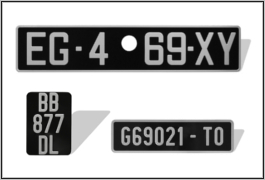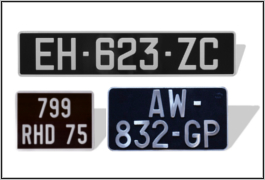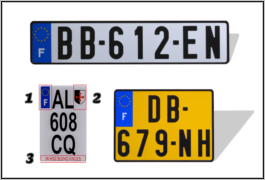|
Add to cart
Product added to the basket The stock is insufficient - units have been added to cart Total:
|
|
Out of stock
Contact us by WhatsApp to request availability
|
|
Minimum purchase quantity
The minimum purchase quantity is not reached
|
REGULATIONS FOR FRENCH VINTAGE LICENSE PLATES
Information provided for reference purposes only. We recommend checking the official state websites for current regulations.
Custom French License Plate Regulations
Regulations for French Black Vintage Plates
Regulations for Yellow and White Plates
Motorcycle Plate Dimensions in 2017
As of July 1st, 2017, the approved size for French motorcycle license plates is 21x13 cm. Dashes between numbers and letters are mandatory. While we continue to offer smaller, custom sizes for collectors and enthusiasts, these sizes are **not** street legal for use on public roads.
Explore our complete range of motorcycle plates.
French Black License Plates for Vintage Cars
Any vehicle registered in France **before January 1st, 1993** and with no changes to its registration number is eligible for black plates. These black plates are a throwback to the earlier French registration style.
Additionally, vehicles with a **“carte grise de collection”**, which is a special registration for historic vehicles in France, can use black plates even if their registration number was issued after 1993.
For all number formats similar to AB-123-CD, the dashes are required by law.
Example: I own a 1987 Honda VFR 750R RC30 that was re-registered in the French system (SIV) in 2017 with “collection” status. I can legally use a black plate for it.
Explore our full range of black vintage license plates.
French Yellow and White License Plates
French yellow plates were traditionally used at the rear of vehicles registered between 1993 and 2009 under the **FNI system** (the previous French vehicle registration system). Vehicles registered during this period could also have **white plates** with the European Union’s “F” on a blue band, which could be placed at the front or rear.
For vehicles registered after 2009 under the **SIV system** (the current French vehicle registration system), plates must feature the EU “F” logo along with a regional identifier. Dashes between the letters and numbers are mandatory.
Example: My 2004 Renault Twingo has kept its original registration number (19 YC 74). It can legally use two white plates or one white plate in the front and a yellow one at the rear.
Explore our range of yellow and white license plates.
Vinyl Adhesive License Plates
The legality of vinyl adhesive license plates in France depends on several factors. Technically, French law does not specifically require that plates be made of aluminum or plastic—they can be made of vinyl. However, to be street legal under the **SIV system**, a vinyl plate must comply with strict requirements: it must have the official dimensions, a retro-reflective white background, legal markings, and black alphanumeric characters with dashes at the correct size. The plate also needs proper marking, including a lot number and date of manufacture, and it must be permanently fixed to the vehicle. Plates must also meet specific French standards, such as **TPPR/TPMR**, which are regulatory certifications for the materials used in plate production.
That said, no major manufacturer currently produces fully approved vinyl plates in France, so **vinyl adhesive plates are not legal for use on public roads**. However, these plates are popular with collectors for use on circuits or at private events.
Example: My 1970 TVR doesn’t have a dedicated spot for a front plate, so I could use a vinyl adhesive plate in a visible position, but it wouldn’t be street legal in France.
Explore our range of vinyl adhesive license plates.

|
Alert
Please enter the required fields! |








